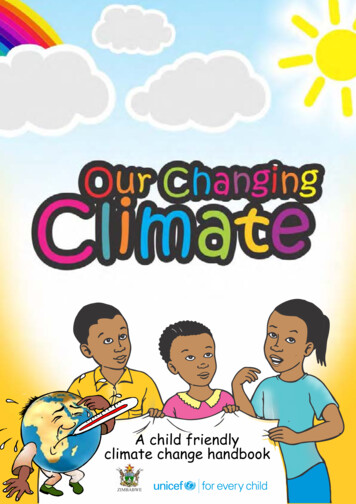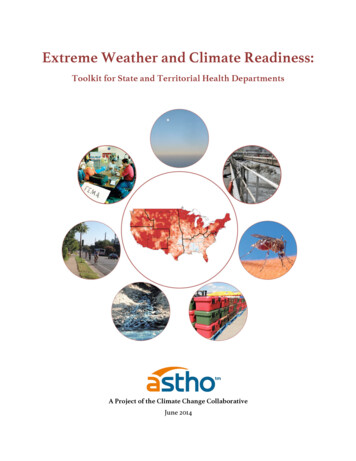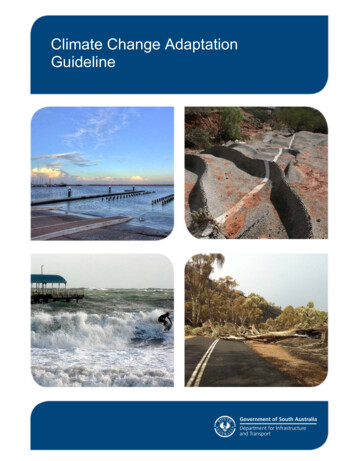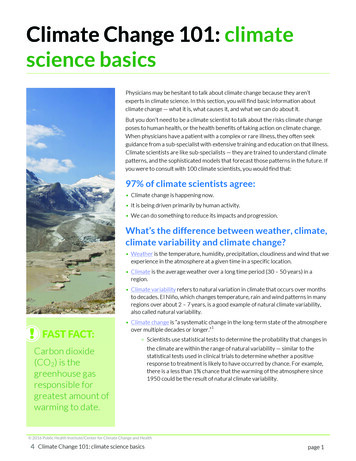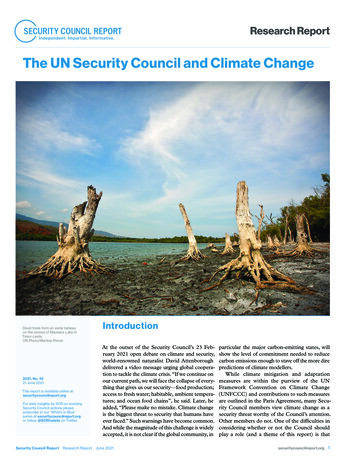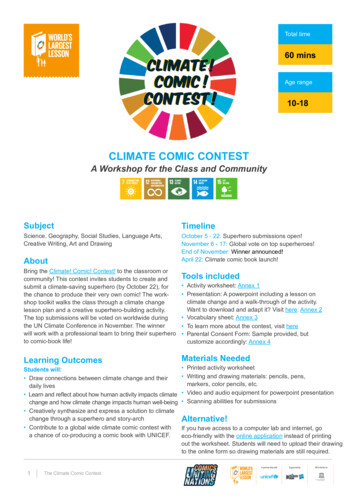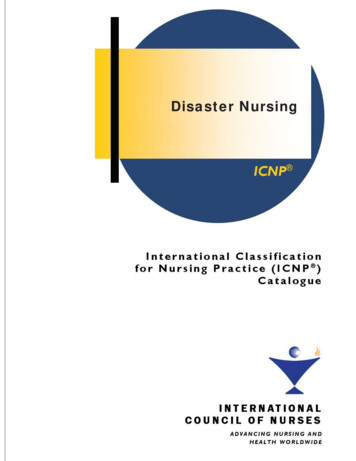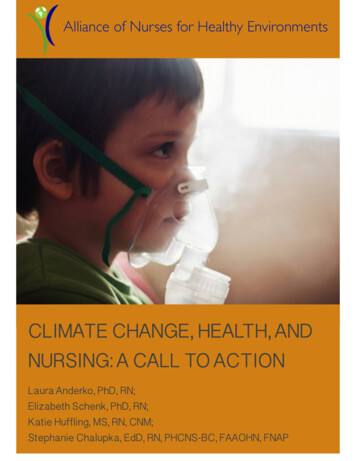
Transcription
Alliance of Nurses for Healthy EnvironmentsCLIMATE CHANGE, HEALTH, ANDNURSING: A CALL TO ACTIONLaura Anderko, PhD, RN;Elizabeth Schenk, PhD, RN;Katie Huffling, MS, RN, CNM;Stephanie Chalupka, EdD, RN, PHCNS-BC, FAAOHN, FNAP
Nurses at ANHE White House Summit, May, 2016Executive SummaryNurses are trusted health professionals in unique positions to inform and mobilize society to acton climate change. In May 2016, the Alliance of Nurses for Healthy Environments (ANHE), inpartnership with the White House, held its first summit with national nurse leaders to discuss thecritical importance of fighting climate change to protect the public’s health.This summit highlighted the crucial role of nurses as engaged leaders on climate action. Basedon needs identified at the Summit, this report aims to inform nurses on the science behindclimate change and health and inspire nurses to be leaders in helping our patients, ourcommunities, and our health care institutions engage in climate change mitigation activities andin preparing for potential effects of climate change through adaptation strategies.The earth’s temperature is increasing, mainly due to human activities, leading to an increase ingreenhouse gas emissions including methane, carbon dioxide, and nitrous oxide. Theseemissions come from energy production and use, transportation, industry (including healthcare),and agriculture. These changes are occurring globally at a rate that exceeds what the world hasexperienced over the last 650,000 years (Perry, et al, 2007). Health impacts can result fromdirect exposures to climate change through changing weather patterns or indirectly throughchanges in water availability, air quality, agriculture, and the economy. This report describessome of the more common health impacts including mental health issues, heat-related illness,water security and drought, insect-borne illnesses, and respiratory diseases, along withnursing’s role in addressing these issues.Costs of climate change on health have been slow to emerge in the research literature, resultingin substantial underestimates of climate change costs. Although the evidence is incomplete,findings suggest significant health costs. Groups sensitive to adverse health impacts fromclimate change include those living in poverty, the elderly, children, and indigenous populations.These sensitive groups together comprise a majority of the human population. By focusing onprotecting these groups, we protect all of society.Climate changes are expressed differently across the nation based on geography such asproximity to oceans and rivers; and underlying weather patterns including precipitation andstorm trends. This report explores regional differences through case studies concluding withopportunities for nurses to reduce harm by mitigating and adapting to these changes. Todescribe the many ways nurses are leading the profession in addressing climate change,nurses’ voices are highlighted through short video stories. As the nation’s most trustedprofessionals, nurses can lead the charge to significantly improve society’s response to climatechange and foster the strategies needed for a healthy future for everyone.
CLIMATE CHANGE, HEALTH, AND NURSING: A CALL TO ACTIONTable of ContentsIntroduction - p.4Sources of Greenhouse Gases - p.4Review of the Science - p.5Health Impacts of Climate Change - p.5Health Disparities - p.8Regional Highlights: Climate Change and Health - p.9Nurses’ Professional Obligation - p.23Nurses Leading the Way - p.26Nurses Voices from across the Nation: Personal Stories - p.27Conclusion - p.28Resources - p.30References - p.31The Alliance of Nurses for Healthy Environments (ANHE) is a national coalition of nursingorganizations and individual nurses who believe that the environment and human health areinextricably linked. Our mission is to promote healthy people and healthy environments byeducating and leading the nursing profession, advancing research, incorporating evidencebased practice, and influencing policy. Learn more about the ANHE at www.envirn.orgPage 3Alliance of Nurses for Healthy Environments
CLIMATE CHANGE, HEALTH, AND NURSING: A CALL TO ACTIONIntroductionNurses are on the front lines caring for America’s health. We are the most trusted sources ofinformation to the American public and we are in every community. We are in hospitals, clinics,schools, workplaces, nursing homes, and people’s homes. Due to our unique position withinhealthcare and our communities, on May 25th, 2016, the White House, in partnership with theAlliance of Nurses for Healthy Environments (ANHE), hosted representatives from leadingnational nurses’ organizations to discuss the critical importance of fighting climate change toprotect public health.In light of the current and predicted health threats from climate change, this historic eventfocused on how nursing organizations can address this public health crisis. Nurses educatetheir members, lead research, incorporate climate change into nursing practice and education,and participate at the local, state, and federal levels on climate policies like the EnvironmentalProtection Agency (EPA)’s Clean Power Plan, which sets the first national limits on carbonpollution from power plants.Climate change is causing extended heat spells; both flooding and droughts across the country;extreme weather events; larger and hotter forest fires; and threatened food crops. There is awide range of human health, safety, and mental health threats posed by the impacts of climatechange.With this report, we aim to inform nurses on the science behind climate change and health. Ourhope is to inspire nurses to be leaders in helping our patients, our communities, and our healthcare institutions engage in climate change mitigation activities and in preparing for potentialeffects of climate change. We are in a very critical time in history; we need all nurses’ hands,minds, and hearts on deck as we address the challenges posed by climate change.Figure 1. Sources of Greenhouse GasesGreenhouse gases trap heat in the atmosphere, warming the planet. The largest source of greenhousegas emissions from human activities in the United States is from burning fossil fuels for electricity, heat,and transportation. The primary greenhouse gases include carbon dioxide, methane, nitrous oxide, andfluorinated gases. Primary sources of carbon dioxide are from burning fossil fuels (coal, natural gas,and oil); for methane, it is through the production and transport of coal, natural gas, and oil and alsofrom livestock and the decay of organic waste in landfills; for nitrous oxide it is through agricultural andindustrial activities; and for fluorinated gases it is through a variety of industrial processes (EPA, 2016b).GlobalGreenhouseGasEmissionsby CC, 2014)Page 4Alliance of Nurses for Healthy Environments
CLIMATE CHANGE, HEALTH, AND NURSING: A CALL TO ACTIONFigure 2. Impact of Climate Change on Human Health (CDC, 2016)Review of the ScienceThe earth’s temperature is increasing mainly as a result of human activity, such as burning fossilfuel leading to an increase in greenhouse gas emissions including methane, carbon dioxide,and nitrous oxide. These emissions come from energy production and use, transportation,industry (including healthcare), and agriculture. These changes are occurring globally at a ratethat exceeds what the world has experienced over the last 650,000 years (Parry et al., 2007).Climate change leads to extreme weather events such as heat waves, melting of snow and icewith rising sea levels, changes in precipitation resulting in flooding and drought, more intensehurricanes and storms, wildfires, as well as poorer air quality. Climate change impactsagriculture, infectious disease, allergies, and livelihoods. There is growing evidence andconcern about the impacts of climate change on health and how to respond to these impacts.Health Impacts of Climate ChangeHealth impacts can result from direct exposures to climate change through changing weatherpatterns (e.g., heat waves) or indirectly through changes in water availability, air quality, andresultant changes in agriculture and the economy. Figure 2 (CDC, 2016), provides informationbased on the Third National Climate Assessment, describing the wide-ranging health impactsPage 5Alliance of Nurses for Healthy Environments
CLIMATE CHANGE, HEALTH, AND NURSING: A CALL TO ACTIONfrom climate changes such as rising temperatures, rising carbon dioxide levels, rising sealevels, and more extreme weather (CDC, 2016). Some of the more common climate changesand related health impacts are described.Heat-Related IllnessAverage global temperatures are increasing and are this trend is expected to continue. Healthconsequences of increasing global temperatures include rising rates of heat stress andexhaustion, heat cramps, heat stroke, and death. With the anticipated increase in intensity andfrequency of extremely hot weather events the impact on human health is expected to risedramatically (Amengual, Homar, Brooks, Ramis, Gordaliza & Alonzo, 2014). Heat-relatedmortality in US cities is expected to more than double by the mid- to-late 21st century (Stone,Vargo, Habeeb, DeLucia, Trail, Hu & Russell, 2014). In the U.S., extreme heat events alreadycause more deaths annually than all other extreme weather events combined (Portier & Tart,2010). Much of the excess mortality from heat waves is concentrated in infants, children, andthose with chronic illnesses and those over 65 (Amengual, Homar, Brooks, Ramis, Gordaliza &Alonzo, 2014; Haines & Patz, 2004; Portier & Tart, 2010). Those living in urban environmentsare at added risk because of heat trapping materials used in the construction of roads andbuildings such as concrete. Additionally, cities lack significant tree cover, exacerbating the hightemperatures. Cities frequently experience ambient air temperatures from 1.8–5.4 F (1–3 C)warmer than the surrounding rural and suburban areas. This “urban heat island” also absorbsheat during the daytime and radiates it outward at night, raising nighttime minimumtemperatures by 22 F (12 C) (Environmental Protection Agency (EPA, 2011a).Water Security and DroughtWater security or the reliable availability of water for drinking, agriculture, manufacturing, andmany other uses, is essential to human health. However, floods and droughts that result fromclimate change can dramatically impact water availability and surface water quality (Delpla etal., 2009). In Southern U.S. states, droughts have become a more frequent occurrence;Western states have experienced water shortages worsened by reduced mountain snowpackattributable to global warming (Portier & Tart, 2010).Insect-Borne IllnessesMany major infectious disease agents (such as bacteria and viruses) and the vectors ororganisms that carry them (e.g. mosquitoes) are highly sensitive to temperature and rainfall(Patz, Campbell-Lendrum, Holloway & Foley, 2005). Warming trends have impacted the rangeand incidence of vector borne diseases. As environmental conditions change, the geographicrange of the vectors for illnesses is extended, increasing the potential for infection. Changes inclimate may make insect-borne diseases harder to control. For example, as temperatureincreases, the malaria parasite reproduces at a higher rate and mosquitoes feed morefrequently.Respiratory DiseaseBy 2020, it is predicted that health impacts from climate change and ozone pollution will result insignificant increases in acute respiratory symptoms, asthma-related emergency room visits,weather-related hospital admissions for infants and the elderly, lost school days, and prematuredeaths (Costello et al., 2011). Small changes in temperature (a degree or two) coincide withincreasing ground-level ozone and, with it, a significant effect on death rates. An estimated3,700 deaths annually can be attributed to these small increases in ozone levels (Bell et al.,2004; Bell et al., 2008; Perera & Sanford, 2011). Climate change and resulting air pollutionposes a serious threat to respiratory health (Babin et al., 2007; Ebi et al., 2006; Ebi & McGregor,Page 6Alliance of Nurses for Healthy Environments
CLIMATE CHANGE, HEALTH, AND NURSING: A CALL TO ACTION2008; Parry et al., 2007). Global warming has caused an earlier onset of the spring pollenseason in the Northern Hemisphere (Metz et al., 2007) and increased the production ofallergens (e.g., ragweed). Temperature increases and increased carbon dioxide (CO2)concentrations produce earlier flower blooming, affecting the timing and distribution of allergenssuch as pollen. It is anticipated that respiratory allergies and asthma will become more commonand severe because of increased exposure to pollen, molds, and air pollution as a result ofclimate change (D’Amato et al., 2010; Ebi et al., 2008).Mental HealthClimate change may affect mental health directly by exposing people to trauma (Berry, Bowen &Kjellstrom, 2010). Adverse psychiatric outcomes are well documented in the aftermath of naturaldisasters (Page & Howard, 2010), and can include both acute traumatic stress and morechronic stress-related conditions (such as post-traumaticstress disorder). Extreme heat events, which arebecoming more common, have been associated with aVulnerable or sensitivegeneral increase in aggressive behavior, higher rates ofgroups together comprisecriminal activity, and increased suicide rates (Berry et al.,most of the members of2010). There will likely be an increase in the overallthe human population. Byburden of mental disorders worldwide as extreme weatherconditions and natural disasters can lead to displacement,focusing on protectingloss, and social disruption. Those who are alreadythem, we protect all of us.vulnerable to stress-related disorders and mental healthdisease are at even higher risk following extreme weatherconditions.Financial ImpactsEmerging research indicates that the costs of climate changes are substantial. A study in 2010found that economic losses from climate-related disasters, not including health care costs, hadsoared from 5 billion to 27 billion US dollars annually from 1970 to 2010 (Reichenmiller,2010). Recent estimates indicate that climate change and weather disasters in 2012 cost theAmerican economy more than 100 billion (EPA, 2016).Costs of climate change on health have been slow to emerge in the research literature, withlimited inclusion in valuations of climate change damages, resulting in substantialunderestimation of climate change costs (Knowlton, 2011). Although the evidence is incomplete,findings suggest significant health costs (Hutton, 2011).A study investigating six climate-related events found that health costs from premature deathsand illness surpassed 14 billion between 2002 and 2009. These six events included ozonesmog pollution, heat wave, hurricane, wildfire, mosquito-borne infectious disease, and riverflooding (Knowlton, 2011).In an often-overlooked cause of greenhouse gases, Springmann et al. (2016) found that movingtoward more plant-based diets from animal-based diets (a source of methane gas) could reduceglobal mortality by 6–10% and food-related greenhouse gas emissions by 29–70% in 2050. Theeconomic benefits of moving to plant-based diets was found to be 1–31 trillion US dollars, in2050.The benefits of health adaptation strategies are difficult to measure. Environmental healthinterventions cannot be evaluated within the same framework as other health interventions,Page 7Alliance of Nurses for Healthy Environments
CLIMATE CHANGE, HEALTH, AND NURSING: A CALL TO ACTIONwhich have a more narrowly defined scope and range of costs and benefits. Many impacts areintangible or difficult to measure such as a reduction in the quality of life (Hutton, 2011).Economic evaluations of environmental health interventions such as adaptation are highlyuncertain, due to methodological difficulties, lack of reliable data and an inability to generalizefindings across settings (National Environmental Health Council, 2016).Despite these difficulties there has been some research conducted on health adaptationstrategies. In one study, it was found that the cost of running a heat–health warning system forPhiladelphia was relatively small (US 210,000) compared with the benefits of saving lives (US 468 million) (Ebi et al., 2004).A final consideration is the impact of policies on the costs and benefits related to climatechanges. One policy that has been studied is the Clean Air Act. The EPA found that in 2010,approximately 1.3 trillion dollars was gained in public health and environmental benefits as aresult of Clean Air Act amendments for a cost of 50 billion dollars (Johnson, 2011). The EPAestimates that in 2020, the US will experience a gain of approximately 2 trillion dollars inbenefits at a cost of 65 billion dollars.A series of studies found that implementing the Clean Air Act actually increased the size of theeconomy through improved health and a more productive workforce. This resulted in anincreased net economic output (Goodstein et al., 2010; EPA, 2011b; Jorgenson et al., 2004).Jorgensen et al. (2004) found that by 2010, the Gross Domestic Product (GDP) wasapproximately 1.5 percent higher than expected as a result of the Clean Air Act.More recently, the Clean Power Plan is predicted to prevent 2,700 to 6,600 premature deathsand 140,000 to 150,000 asthma attacks in children, leading to climate and health benefits worth 55 billion- 93 billion dollars per year by 2030 (EPA, 2016).Health DisparitiesThough all humans are at risk from impacts from climate change, some groups and individualsare at higher risk. This health disparity is an important consideration in identifying anddecreasing likely harm.Around the world, the poor are at higher risk for damage from storms, flooding and drought,infectious disease, and pollution. The poor have fewer resources for adequate housing, foodsecurity and sometimes education. In addition, the poor are likely to live in countries, regions orneighborhoods with less infrastructure such as emergency response, food banks, back-uphousing and healthcare. People in poverty may feel less empowered to advocate for betterpreparedness in their communities. These elements put them at higher risk for disease, injury ordisplacement that may result from climate change impacts (Luber, et.al, 2014).Indigenous people are also at higher risk (Bennet, et.al, 2014). Native peoples in many placessubsist off the land for wild food and crops, for cultural items, and for housing. Each of these arethreatened with climate change. In the north, Alaska Native communities are threatened withdamage to infrastructure due to loss of permafrost, and loss of communities due to sea levelrise. In the southern US, desert native communities are at increased risk of drought and heat.Urban elderly people may be at-risk. In cities, elderly may live in older homes or apartments,some without adequate ventilation as temperatures rise. They may be more isolated, and it maybe challenging to leave their homes and reach help. Elderly people may be more sensitive toPage 8Alliance of Nurses for Healthy Environments
CLIMATE CHANGE, HEALTH, AND NURSING: A CALL TO ACTIONheat and susceptible to dehydration. They are more likely than younger people to have comorbidities which may then be exacerbated by increased heat and air pollution. They are alsomore likely to be on medications whose actions may be altered by heat.Children around the world are more at risk to climate change impacts (Harvard, 2016). Infantscan be quite sensitive to heat, dehydration, pollution, and infection. Children of all ages aremore impacted by pollution, trauma, dehydration, and starvation than healthy adults.Women are more impacted than men in several aspects. Smaller body size on average mayincrease sensitivity to heat, dehydration, and pollution. Women are often the primary providersof care for infants and children, thus their health impacts the health of others. Climate changeimpacts may put women more at risk of disease, malnutrition, dehydration, injury, sexualviolence, mental health challenges, obstetrical difficulties, and death.People of all ages with underlying disease are at increased risk due to climate change. Peoplewith cardiac disease, including coronary artery disease and congestive heart failure, are athigher risk during heat events and pollution events. People with asthma, COPD and lungdisease are at risk during high temperatures, increased ground level ozone, and forest fires.People with diabetes or obesity are at higher risk of morbidity and mortality during heat waves.In addition, climate change may increase the risk of diabetes as it interrupts healthy foodsystems and makes mobility more difficult.Regional Highlights: Climate Change and HealthClimate change causes many different impacts, stemming primarily from the warming of theglobe and its downstream effects. We see increased heat, changes in precipitation andavailable moisture, and movement of infectious disease vectors to niches where they have notpreviously been. We see increased air pollution, worse storms, and challenges to health andmental health. These impacts from climate change are expressed differently across the nationbased on geography such asaltitude; proximity to oceans andrivers; underlying weather patternsincluding precipitation and stormpatterns; and infrastructure that mayinfluence vulnerability.In the following section, each ofeight regions across the US will beaddressed, moving from east towest: Northeast, Southeast,Midwest, Great Plains, Northwest,Southwest, Alaska, and US Islands.The key climate-related risks ineach region will be described,followed by an example ofchallenge or success and adescription of how nurses can beengaged to decrease harm.Figure 3. US Map of National Climate Assessment Regions (EPA, 2016d)Page 9Alliance of Nurses for Healthy Environments
CLIMATE CHANGE, HEALTH, AND NURSING: A CALL TO ACTIONExtreme Weather in the Northeastern United StatesThe 12 northeastern states form a high-density urban coastal corridor from Washington, D.C.,north to Boston in which 64 million people are concentrated. While the northeastern statesinclude diverse built and natural environments, they all include populations that have beenshown to be highly vulnerable to climate hazards and other stresses. The northeastern statesdepend on aging infrastructure that has already been stressed by climate hazards includingheat waves, as well as coastal and riverine flooding due to a combination of sea level rise,storm surge, and extreme precipitation events. The Northeastern United States is frequentlyimpacted by extreme weather events such as ice storms, floods, droughts, heat waves,hurricanes, and major storms in the Atlantic Ocean off the northeast coast, referred to asnor’easters (Melillo et al., 2014).Between 1895 and 2011, temperatures in the Northeast increased by almost 2 F (0.16 F perdecade), and precipitation increased by approximately five inches, or more than 10% (0.4inches per decade) (Kunkle, Stevens, Sun, Janssen, Wuebbles, et al., 2013). Coastal floodinghas increased due to a rise in sea level of approximately 1 foot since 1900. This rate of sealevel rise exceeds the global average of approximately 8 inches. The Northeast hasexperienced a greater recent increase in extreme precipitation than any other region in theUnited States. Between 1958 and 2010, the Northeast saw more than a 70% increase in theamount of precipitation falling in very heavy events (defined as the heaviest 1% of all dailyevents) (Groisman, Knight & Zolina, 2013).While the intensity, duration, and frequency of cold air patterns is expected to decrease in thenortheastern states, winter and spring precipitation is projected to increase (Liu, Curry, Wang,Song, & Horton, 2012). As the century progresses, the frequency of heavy downpours isprojected to continue to increase. As temperatures rise, leading to greater evaporation andearlier winter and spring snowmelt, in the Northeast so will seasonal drought risk. It is projectedthat by 2100, sea levels will rise one to four feet. However, sea level rise along most of thecoastal Northeast is expected to exceed the global average rise. The frequency of dangerouscoastal flooding throughout most of the Northeast would more than triple with a sea level rise oftwo feet, in the absence of any changes in storms. Although individual hurricanes cannot bedirectly attributed to climate change, Hurricanes Irene and Sandy demonstrated the vulnerabilityof the Northeastern United States to extreme weather events and the potential for adaptation toreduce impacts.Case in PointIn October, 2012, Hurricane Sandy impacted 14 US states and Washington, DC, causingparticularly severe damage in New York and New Jersey.Hurricane Sandy was the secondcostliest hurricane in US history, resulting in 43 fatalities and thousands of injuries (Gibbs &Holloway, 2013). Flooding and power outages from the storm necessitated the evacuation ofhospitals, skilled nursing and assisted living facilities. In New York City, approximately 6,300patients had to be evacuated from 37 health care facilities. Widespread power outages forcedhospitals to rely on backup generators, which subsequently failed because of flooding. Whenhealth care facilities evacuated, neighboring institutions received the displaced patients (Adaljaet al., 2014).Restoring the facilities took months at massive costs. Superstorm Sandy resulted in the loss of15% of the total bed capacity in New York City. Five hospitals were completely closed and 5,000nursing home were also lost, severely testing the limits of the regional health care system forweeks and months beyond the event itself.Page 10Alliance of Nurses for Healthy Environments
CLIMATE CHANGE, HEALTH, AND NURSING: A CALL TO ACTIONFigure 4. Spaulding Rehabilitation Center; Steinkamp Photography, courtesy Perkins Will.Spaulding Rehab is on the water where the Little Mystic Channel meets the Inner BostonHarbor.Many of the hospital’s resilience features were implemented in response to floodingrisk.One northeastern hospital, Spaulding Rehabilitation Hospital (SRH) in Charlestown,Massachusetts, has been designed with climate change in mind. Based on lessons learned inHurricanes Sandy and Katrina about the need to build resiliency into hospital planning andoperations, Spaulding Rehabilitation Hospital, while located on the waterfront, will be able tocontinue operations in the event of extreme weather events, storm surge or sea level rise. Thehospital was designed to protect patients and employees from the effects of extreme weatherand long-term climate change and maintain basic building systems and services for a period ofat least four days from the onset of an emergency.Informed by the experiences of hospitals in New Orleans during Hurricane Katrina, SRH wasbuilt much higher than was required by building codes. The first floor of the hospital is 30 inchesabove the 500-year flood elevation, keeping water out even with a catastrophic flood. This wasdone because hospital leaders recognized that sea level rise would change flood elevations inthe years to come and thus the hospital would be protected.While both Hurricanes Sandy and Katrina left hospitals without power and air conditioning,Katrina left hospitals without power or air conditioning with temperatures above 100 F in thehospitals. Since evacuating patients in Hurricane Katrina was impossible, hospital staff wasforced to break windows to get fresh air into the building. At SRH, windows are key-controlledand can be opened in an emergency.Page 11Alliance of Nurses for Healthy Environments
CLIMATE CHANGE, HEALTH, AND NURSING: A CALL TO ACTIONSRH is designed and built to provide for sheltering in place by providing passive survivability,the ability to maintain livable conditions in the event of lost power or heating fuel. The entire firstfloor of the hospital can be flooded with only minor damage and while enabling the upper floorsof the building to remain fully occupied and operational. So that the hospital can remainoperational in the most extreme weather events, all mechanical and critical infrastructure ofSRH is located on the roof or a penthouse floor above the eight hospital floors.What Can Nurses Do?It is imperative that nurses are prepared in disaster preparedness in areas prone to flooding andhurricanes that can lead to a disruption in community infrastructure and services. The Universityof Miami School of Nursing and Health Studies has a program that prepares nursing students tobe prepared in addressing the health impacts of climate change. It has implemented arequirement for students to be certified in disaster preparedness: t-the-ready/. Students receive National Incident Management System(NIMS) and Incident Command System (ICS) certifications and are ready to deploy with theMedical Reserve Corps.Flooding in the SoutheastThe Southeast region of the US is made up of a diversity of ecosystems and climates, spanningfrom the coastal plains of the east to the Appalachian Mountains in the west. There are morethan 80 million people living in this region, with populations clustered in major cities such asMiami, New Orleans, and Atlanta and 11 of the fastest growing metropolitan areas in the countryare found in the Southeast (EPA, 2016c).The majority of states in this region have coastlines on either the Atlantic Ocean or the Gulf ofMexico, with over 29,000 miles of coastline in this region. This puts the region at risk fromincreasingly intense hurricanes, sea level rise, and storm surges.Sea level rise is being caused by both the warming of the oceans, causing the water to expand,and melting of land ice suchas glaciers and ice capswhich are adding to theocean’s wate
nursing's role in addressing these issues. Costs of climate change on health have been slow to emerge in the research literature, resulting in substantial underestimates of climate change costs. Although the evidence is incomplete, findings suggest significant health costs. Groups sensitive to adverse health impacts from



